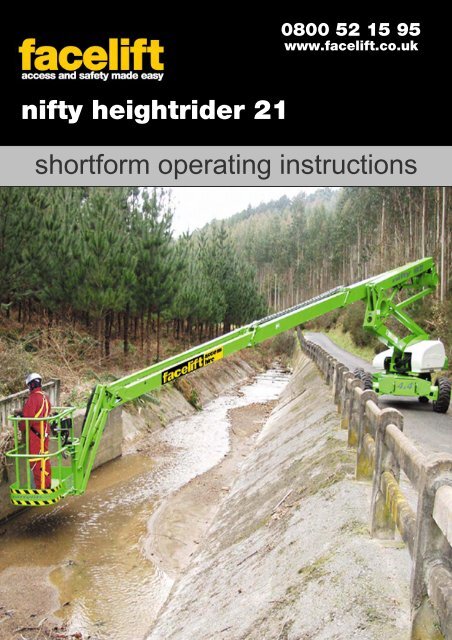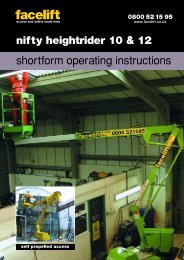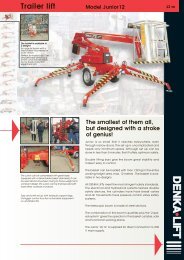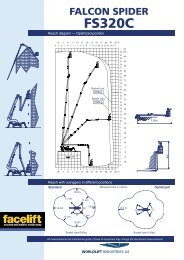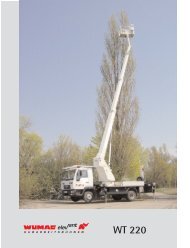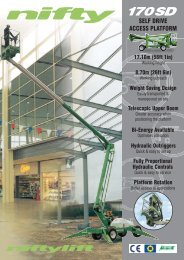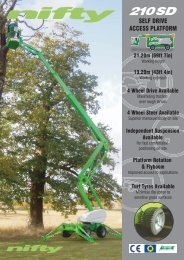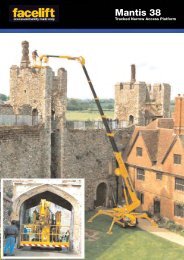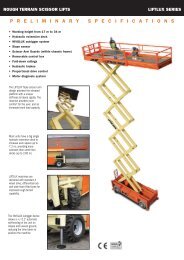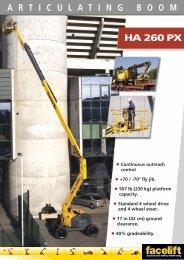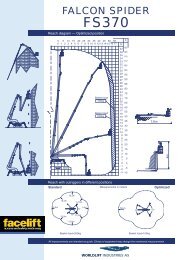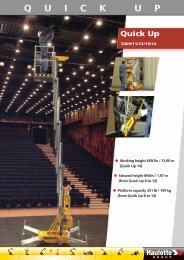HR21 Operators Manual - Facelift
HR21 Operators Manual - Facelift
HR21 Operators Manual - Facelift
- No tags were found...
You also want an ePaper? Increase the reach of your titles
YUMPU automatically turns print PDFs into web optimized ePapers that Google loves.
B0800 52 15 95www.facelift.co.uknifty heightrider 21shortform operating instructions
SAFETY TIPSALWAYS• Inspect your machine before use.• Check all operations including ground controls.• Check ground conditions.• Check clearance from overhead obstructions (powercables, building projections etc).• Plan your task/job.• Use sole boards under your outriggers at all timesregardless of ground conditions.• Stabilise and level machine before use.• Wear a safety harness connected to a suitableanchorage point inside the platform.• Operate all controls smoothly.• Warn other people that you are there by means offlashing lights, sign and cones.• MAKE SAFETY YOUR No.1 PRIORITY.NEVER• Use an unsafe machine.• Use an access platform to hoist loads like a crane.• Overload cage/platform.• Operate in strong winds (Check manufacturer’srecommendation).• Rest the cage on a structure or object to gainextra support.• Attach your safety harness to a structure outside ofthe platform.• Throw or drop anything from the platform.• Use boxes, ladders or stand on handrails to gain additionalheight, if you can’t reach, you need a bigger machine.• Let an untrained person operate the access platform.• Take unnecessary risks (hospitals and graveyards arefull of dead heroes!)In the unlikely event that your machine develops a faultplease contact the <strong>Facelift</strong> Tech Team on 01444 881100CONTENTSRegular Machine Checks...............................3Operating & Safety Instructions.....................5Machine Controls.......................................6Emergency Controls..................................102
Regular Machine Checks3.3 PRE-OPERATIONAL SAFETY CHECK SCHEDULESBefore use each day and at the beginning of each shift the aerial platform shall be given a visualinspection and functional test including, but not limited to, the following:3.3.1 DAILY SAFETY CHECKS1) Check that all labels (decals) are in place and legible.2) Visually inspect the machine for damaged or loose components.3) Check that batteries are charged (i.e. Charger has a solid green light and a pulsing red light).4) Check the fuel level (if applicable).5) Check that canopies/covers and guards are in place and secure.6) Check that the boom rest switch is operable (if applicable).7) Check that control levers are secure and operate freely.8) Check that operating buttons and emergency stop buttons function properly.9) Check the operation of the emergency hand pump.10) Visually inspect all hydraulic hoses and fittings for damage or leaks.11) Check that the platform pivot pins and their tag bolts are secure.12) Check that the tilt alarm is functioning properly (On a slope of 5 0 or more the alarm shouldsound and drive should be disabled).13) Check the operation of the cage weigh system (If fitted). See section 4.5.3 for testing andverification procedure.3.3.2 WEEKLY SAFETY CHECKS1) Inspect tyres and wheels for damage and wear.2) Check that the joystick manipulators are secure.3) Check battery fluid levels and specific gravity (after charging) and general condition.4) Check hydraulic oil level (ISO Grade 22).5) Inspect the engine air filter and clean or replace if necessary.6) Inspect hose track for damage or missing parts.123
THIS MACHINE IS NOT INSULATED.If in doubt, contact the appropriate authorities2.1.11 On entering the platform ensure that the drop down entry bar is closed afterwards.2.1.12 Use of an approved safety belt and lanyard, hard hat and appropriate safety clothing is mandatory.Fasten harness to designated harness securing points within the platform and do not remove untilleaving the platform whilst in the stowed position.2.1.13 Always remain standing within the platform. Do not attempt to increase yourheight or reach by standing and/or climbing on the platform guard rails or anyother object. KEEP YOUR FEET ON THE PLATFORM FLOOR. Do not sit,stand or climb on the guard rail, mid rail or boom linkage. Use of planks,ladders or any other devices on the Niftylift for achieving additional height orreach shall be prohibited.2.1.14 Do not use the platform levelling system to artificially increase the outreach of the platform. Neveruse boards or ladders in the platform to achieve the same result.2.1.15 Do not use the platform to lift overhanging or bulky items that may exceed the maximum capacity orcarry objects that may increase the wind loading on the platform. (e.g. Notice boards etc.)2.1.16 The Niftylift shall not be operated from a position on trucks, trailers, railway cars, floating vessels,scaffolds or similar equipment unless the application is approved in writing by Niftylift Ltd in GreatBritain.2.1.17 Always check that the area below and around the platform is clear of personnel and obstructionsbefore lowering or slewing. Care should be taken when slewing out into areas where there may bepassing traffic. Use barriers to control traffic flow or prevent access to the machine.2.1.18 Stunt driving and horseplay, on or around the Niftylift, shall not be permitted.2.1.19 When other moving equipment and vehicles are present, special precautions shall be taken tocomply with local ordinances or safety standards established for the work place. Warnings such as,but not limited to, flags, roped off areas, flashing lights and barricades shall be used.2.1.20 Before and during driving while the platform is elevated the operator shall maintain a clearview of the path of travel, maintain a safe distance from obstacles, debris, drop offs,holes, depressions, ramps and other hazards to ensure safe elevated travel. Maintain asafe distance from overhead obstacles.2.1.21 Under all travel conditions the operator shall limit travel speed according to conditions of groundsurface, congestion, visibility, slope, location of personnel and other factors causing hazards ofcollision or injury to personnel.2.1.22 The aerial platform shall not be driven on grades, side slopes or ramps exceeding those for whichthe aerial platform is rated by the manufacturer.2.1.23 It shall be the responsibility of the user to determine the hazard classification of any particularatmosphere or location. Aerial platforms operated in hazardous locations shall be approved andsuitable for the duty. (See ANSI/NFPA 505-1987 where applicable).4
Operating & Safety Instructions2.1.24 The operator shall immediately report to his supervisor any potentially hazardous location(s)(environment) which become evident during operation.2.1.25 If an operator encounters any suspected malfunction of the Niftylift or any hazard or potentiallyunsafe condition relating to capacity, intended use or safe operation, he shall cease operation of theNiftylift and request further information as to safe operation from his management, or owner, dealeror manufacturer before further operation of the Niftylift.2.1.26 The operator shall immediately report to his superior any problems or malfunctions of the Niftylift,which becomes evident during operation. Any problems or malfunctions that affect the safety ofoperation shall be repaired prior to continued use.2.1.27 The boom and platform of the Niftylift shall not be used to jack the wheels off the ground.2.1.28 The Niftylift shall not be used as a crane.2.1.29 The Niftylift shall not be positioned against another object to steady the platform.2.1.30 Care should be taken to prevent rope, electric cords and hoses from becoming entangled in theaerial platform.2.1.31 Batteries shall be recharged in a well-ventilated area free of flame, sparks or other hazards, whichmay cause explosion. Highly explosive hydrogen gas is produced during the charging process.2.1.32 When checking electrolyte levels great care should be taken to protect eyes, skin and clothing.Battery acid is highly corrosive and protective glasses and clothing is recommended.2.1.33 If the platform or elevating assembly becomes caught, snagged or otherwise prevented from normalmotion by adjacent structure or other obstacles, such that control reversal does not free theplatform, all personnel shall be removed from the platform safely before attempts are made to freethe platform using ground controls.2.1.34When the machine is not in use always stow the booms correctly.NEVER LEAVE THE KEYS IN THE MACHINE, if it is to be left for anyperiod of time. Use wheel chocks if leaving on an incline.2.1.35 The engine must be shut down while fuel tanks are being filled. Fuelling must be done in a wellventilatedarea free of flame, sparks or any other hazard that may cause fire or explosion. PETROL(GASOLINE), LIQUID PROPANE AND DIESEL FUELS ARE FLAMMABLE.2.1.36NEVER START THE NIFTYLIFT IF YOU SMELL PETROL (GASOLINE),LIQUID PROPANE OR DIESEL FUEL. THESE FUELS ARE HIGHLYFLAMMABLE2.1.37 The operator shall implement means provided to protect against use by unauthorised persons.2.1.38 Never remove anything that may affect the stability of the machine such as, but not limitedto, batteries, covers, engines, tyres or ballast.59
4.2 GROUND CONTROL OPERATION4.2.1 GROUND CONTROL FUNCTIONSOperating & Safety Instructions1032(Base Button Box)405P16752/011 Emergency Stop Push to Stop machine Turn clockwise to Release2 Diesel Glow/Start Selector Turn Clockwise – Glow, Off and Start posistions3 Cage Overload Indicator4 Base/Platform Selector Up for Booms Down for Base5 Green Power Button Push and hold to activate machineP14018/0011 2 3 4 5 6(BaseLevers)1 Operates Platform Levelling Up for Forward ** Down for Backward **2 Operates the Flyboom Up for Up Down for Down3 Operates Telescoping Up for Tele Out Down for Tele In4 Operates the Link Booms Up for Up Down for Down5 Operates the Upper Boom Up for Up Down for Down6 Operates Swing Up for Right Down for Left** Platform levelling only active when booms are down56
Operating & Safety Instructions4.2.2 OPERATIONALWAYS ALLOW THE ENGINE TO WARM UP BEFORE OPERATING.ALL MODELS1) Ensure all red emergency stops are out.2) Turn Base/Platform selector at ground control station to Ground (Clockwise).DIESEL ENGINE3) COLD ENGINE: - turn the Diesel Glow/Start selector to the Glow position (anti-clockwise).This engages the glow plug pre-heat system. Hold for 3-5 seconds then turn the key to theStart position (fully clockwise) and the engine will fire.4) WARM ENGINE: - turn the Diesel Glow/Start selector to the Start position (clockwise) andthe engine will fire.ALL MODELS5) Push and hold green power button on the base control box.6) Select a function and operate the appropriate hydraulic lever in full accordance withmanufacturers operating and safety manual.7) To return control to the platform turn the Base/Platform selector to the Platform position(anti-clockwise).8) When not in use return machine to stowed position, turn the Base/Platform selector tocentre Off position, remove key and chock wheels.EMERGENCY PROCEDURES9) Push in red emergency stop to shut down all functions.10) In the event that the controls fail or the operator becomes incapacitated the booms can beoperated by using the hand pump which is located under the canopy next to the basecontrols. To operate:a) Check the selector under the middle bonnet is turned to booms.b) Move and hold lever to be operated.c) Use hand pump lever to move machine.d) Release control lever to halt machine movement267
4.3 PLATFORM CONTROL OPERATION4.3.1 PLATFORM CONTROL FUNCTIONSOperating & Safety Instructions1+ -2 3 45 6(Cage Button Box)0I7 89P14015/0041 Emergency Stop Push to Stop machine Turn clockwise to Release2 Horn Push to sound3 Battery Charge indicator4 Cage Overload Indicator5 Diesel Glow Push to Glow Engine6 Drive Speed Selector Turn Clockwise - Slow, Fast and Rough terrain modes7 Green Power Button Push and hold to activate machine8 On/Off & Diesel Start9 JoystickP14020/0011 2 3 4 5 6(Cage Levers)1 Operates Platform Rotation Up for Clockwise Right for Anti-Clockwise2 Operates the Flyboom Up for Up Down for Down3 Operates Telescoping Up for Tele-In Down for Tele-Out4 Operates the Link Booms Up for Up Down for Down5 Operates the Upper Boom Up for Up Down for Down6 Operates Swing Left for Left Right for Right823
Operating & Safety Instructions4.3.2 OPERATIONNEVER START THE NIFTYLIFT IF YOU SMELL PETROL (GASOLINE), LIQUIDPROPANE OR DIESEL. THESE FUELS ARE FLAMMABLE.BEFORE OPERATING THE NIFTYLIFT ENSURE THAT EACH OPERATOR HASREAD AND FULLY UNDERSTOOD THE OPERATING MANUAL. FAILURE TODO SO MAY RESULT IN DEATH OR SERIOUS INJURY.ALL MODELS1) Ensure all red emergency stops are out.2) Turn the Base/Platform selector at the ground control station to Platform (anti-clockwise).DIESEL ENGINE6) COLD ENGINE: - push the Diesel Glow button to engage the glow plug pre-heat system.Hold for 3-5 seconds then turn the On/Off Diesel Start selector to the Start position(clockwise) and the engine will fire.7) WARM ENGINE: - turn the On/Off Diesel Start selector to the Start position (clockwise)and the engine will fire.ALL MODELS8) Depress the footswitch (if available) or push and hold green power button on the platformcontrol box.9) Select a function and operate the hydraulic control levers in full accordance withmanufacturers operating and safety manual.10) To return control to the base turn Base/Platform selector to the Base position (clockwise).11) When not in use return booms to the stowed position. Turn the Base/Platform selector tothe centre Off position, remove key and chock wheels.ALWAYS ENSURE THE AERIAL PLATFORM IS ON A FIRM LEVEL SURFACEAND THE AREA IS FREE OF ANY OVERHEAD OBSTRUCTIONS.ENGAGING THE RED EMERGENCY STOP BUTTON WILL SHUT DOWN THEENGINE, AND THE ELECTRIC CIRCUIT PREVENTING OPERATION OF ANYFUNCTION.9
4.4 DRIVING CONTROLSOperating & Safety InstructionsDO NOT OPERATE THE NIFTYLIFT WHILST ELEVATED UNLESS ON A FIRM,LEVEL SURFACE FREE FROM ANY POSSIBLE OBSTRUCTIONS ORHAZARDS BOTH AT GROUND LEVEL AND OVERHEAD.1) Check proposed route for possible hazards, obstructions and personnel.2) Depress switch located on the front of the joystick.3) Use the Drive Speed selector on the platform control station to determine speed.Low Drive (Tortoise) - gives low speed and low engine revs..High Drive (Hare) - gives high speed and high engine revs.RT Drive (Rough Terrain) - gives low speed and high engine revs.N.B. High Drive is only available when the booms are in the stowed position. The <strong>HR21</strong> willdefault Low Drive speed whenever the booms are elevated.4) Select drive joystick from the platform control box.A. Up for FORWARDB. Down for REVERSESteering is controlled by the rocker-switch button on the top of the joystickC. Left for STEER LEFTD. Right for STEER RIGHTThe driving horn is activated by the button on the front of the joystick and there is also aseparate horn button on the platform controls for use when the drive and boom controls areswitched off.5) All control levers give a fully proportional response therefore the more the lever is movedaway from the centre Off position the faster the function will become.6) Maximum drive speed is only attainable when all booms are fully stowed and the DriveSpeed selector is in the High Drive (Hare) position.7) When driving with the booms fully stowed, the Tilt Alarm is bypassed to allow the Niftylift tobe driven in areas where the slope exceeds the five-degree working limit. In normal operationthe drive is therefore unaffected when driven onto a slope in excess of five degrees, until thebooms are raised, whereupon the drive would be disabled and the tilt alarm soundscontinuously.8) Under no circumstances should any Height Rider 21 series machine be driven on slopesexceeding the gradeability in the general specification.ALL NIFTYLIFTS ARE FITTED WITH A TILT ALARM - PRE-SET IN THEFACTORY. ONCE ENERGISED THE NIFTYLIFT WILL LOSE ALL POWER TODRIVE FUNCTIONS AND A LOUD AUDIBLE ALARM WILL BE ACTIVATED.TO DE-ACTIVATE, LOWER THE BOOMS FULLY TO STOWED POSITION ANDRE-POSITION BASE ON FIRM, LEVEL GROUND.IF ALARM SOUNDS - DESCEND IMMEDIATELY AND RE-LEVEL MACHINEBASE.10
5 Emergency Controls5.1 GENERALOperating & Safety InstructionsCHECKING THE OPERATION OF THE EMERGENCY CONTROLS EVERY DAYAND/OR BEFORE EACH SHIFT IS AN ESSENTIAL PART OF THE OPERATOR'SDUTIESThe operator and all ground personnel must be thoroughly familiar with the location and operationof the EMERGENCY CONTROLS.5.2 IN THE EVENT OF AN INCAPACITATED OPERATORTurn the Base/Platform selector at ground control station to ground (clockwise). Lower onground controls as detailed under Section 4.2 Ground Control Operation.5.3 IN THE EVENT OF MACHINE FAILUREIf all machine power is lost, the Emergency Hand pump can be used to provide the hydraulicpower to manoeuvre the machine. Lower platform using hand lever controls at ground controlstation.Note: If the machine is fitted with a cage overload system, and the cage comes into contact with afixed object whilst operating at height, this would be detected as an overload condition. All powerto the machine controls would be lost, requiring the machine to be recovered using the EmergencyHand Pump. It is sufficient for the cage to be manoeuvred away from the collision point to re-setthe cage weigh mechanism, thereby restoring normal machine operation. The cage could then bebrought down using the controls as described previously.Opening the nearside machine canopy reveals the ground controls, plus the dedicated hydraulics forthe Emergency recovery of the machine.Primarily there are two emergency hand pumps, one for the boom functions only, mountedseparately and adjacent to the ground control valve block. The second hand pump is specificallyfor the drive system and is incorporated into the Drive Control Valve.1133
Operating & Safety Instructions5.4 BOOM CONTROLSOn opening the canopy cover, the two hand pump handles are revealed. The black handle with ared handgrip fits the Boom hand pump. Remove the handle and fit this to the appropriate pump.When the handle is actuated, hydraulic flow is generated and will be supplied directly to the groundcontrol valve block. Operating the ground control lever will permit the machine to be manoeuvredby the ground personnel.If desired, the Cage operator can hold the appropriate lever to manoeuvre the machine, whilst aground operative provides the motive power using the emergency hand pump. When not in use,the handle should be stowed back in its clips.5.5 DRIVE CONTROLSSituated to the side of the ground controls is found the Drive Control Valve. This valve blockcontrols the drive, brakes and emergency controls for all of the drive functions.Under normal operation the brake release knob should be closed. To do this, turn the red knob fullyclockwise to close that circuit. When the machine is driving, the brake tell-tale will ‘pop’ out toindicate that brake pressure is being generated. The silver hand pump handle fits the integralpump, which is now ready for use.12
5.6 TOWINGOperating & Safety InstructionsTo tow the machine it is necessary to bypass the parking brakes. First, ensure that the machine isrestrained against running away, i.e. positioned on a flat, level surface or adequately chocked ontwo or more wheels in both directions. Moving the machine must not be attempted until adequatemeans to restrain it from running away are in place.Fit the hand pump handle to the drive control valve pump. Push and hold down the brake releaseactuator, whilst pumping the handle. When brake pressure is generated, the brake ‘tell-tale’- willindicate this by ‘popping’ out of the housing.The brakes are now bypassed and the machine is capable of being towed at a low speed. The towvalve, integrated into the drive control valve, is piloted open at the same time as the brakes arereleased, and permits this.To re-set the parking brakes, the brake release knob should be opened. This is the red knob on theside of the Drive Control Valve. Opening this knob allows the brake pressure to dissipate from thebypass circuit, re-setting the parking brakes and de-energizing the tow valve. The machine will nowlock the wheels and deny any attempt at towing.1335
faceliftaccess and safety made easy0800 072 55 72www.facelift.co.ukoperator training centreWhen hiring accessequipment we stronglyrecommend takingadvantage of one of ouroperator training courses.As <strong>Facelift</strong> is an accreditied IPAF (Independent PoweredAccess Federation) training centre you can be sure that yourstaff will be trained to a high standard and receive aninternationally recognised qualification.Courses can take place on your own premises or at one ofour training centres, situated in Hickstead, Iver, Southampton,Liverpool, Birmingham and Basildon.We can train your personnel on anyof the following equipment:(1a) Static VerticalVertical Personnel Platform (static)(1b) Static BoomSelf Propelled Boom with outriggers, Trailer/Pusharound, Vehicle Mounted Platform up to 26m andVehicle Mounted Platform over 26m*(3a) Mobile VerticalScissor Lifts, Vertical Personnel Platform (mobile)(3b) Mobile BoomSelf Propelled BoomSpecialist MachinesSpider*The one day course covers site safety, practical demonstration,sole usage, site risks and includes a theory test* Two day courses are required for the Spider and VehicleMounted Platforms over 26mSuccessful candidates are issued with the IPAF PAL card,widely accepted by both the CITB and Health And SafetyExecutive.For further information or to arrangea training course contact us today on:0800 072 55 72 or training@facelift.co.ukWe also run the following courses:MEWPs for ManagersLoading and UnloadingHarness Use and InspectionPASMA Aluminium Tower TrainingBLMA Ladder Training


